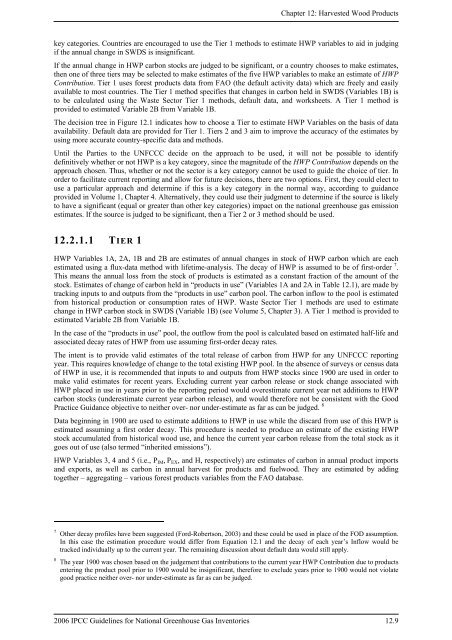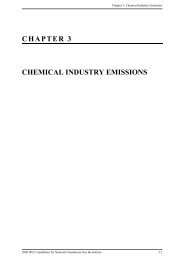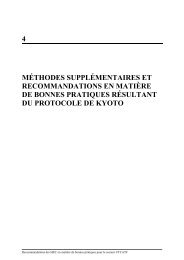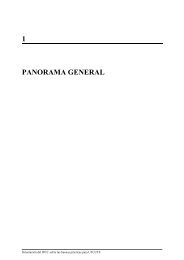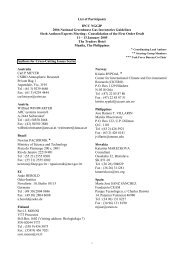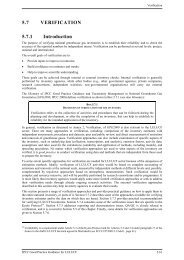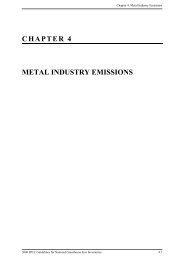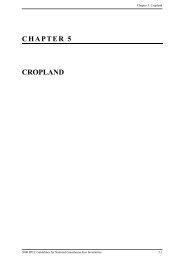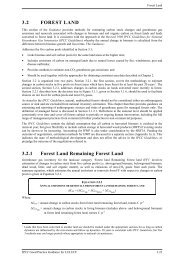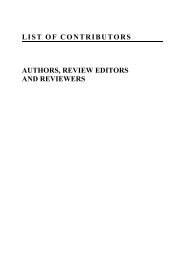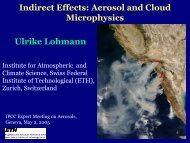chapter 12 harvested wood products - IPCC - Task Force on ...
chapter 12 harvested wood products - IPCC - Task Force on ...
chapter 12 harvested wood products - IPCC - Task Force on ...
Create successful ePaper yourself
Turn your PDF publications into a flip-book with our unique Google optimized e-Paper software.
Chapter <str<strong>on</strong>g>12</str<strong>on</strong>g>: Harvested Wood Products<br />
key categories. Countries are encouraged to use the Tier 1 methods to estimate HWP variables to aid in judging<br />
if the annual change in SWDS is insignificant.<br />
If the annual change in HWP carb<strong>on</strong> stocks are judged to be significant, or a country chooses to make estimates,<br />
then <strong>on</strong>e of three tiers may be selected to make estimates of the five HWP variables to make an estimate of HWP<br />
C<strong>on</strong>tributi<strong>on</strong>. Tier 1 uses forest <str<strong>on</strong>g>products</str<strong>on</strong>g> data from FAO (the default activity data) which are freely and easily<br />
available to most countries. The Tier 1 method specifies that changes in carb<strong>on</strong> held in SWDS (Variables 1B) is<br />
to be calculated using the Waste Sector Tier 1 methods, default data, and worksheets. A Tier 1 method is<br />
provided to estimated Variable 2B from Variable 1B.<br />
The decisi<strong>on</strong> tree in Figure <str<strong>on</strong>g>12</str<strong>on</strong>g>.1 indicates how to choose a Tier to estimate HWP Variables <strong>on</strong> the basis of data<br />
availability. Default data are provided for Tier 1. Tiers 2 and 3 aim to improve the accuracy of the estimates by<br />
using more accurate country-specific data and methods.<br />
Until the Parties to the UNFCCC decide <strong>on</strong> the approach to be used, it will not be possible to identify<br />
definitively whether or not HWP is a key category, since the magnitude of the HWP C<strong>on</strong>tributi<strong>on</strong> depends <strong>on</strong> the<br />
approach chosen. Thus, whether or not the sector is a key category cannot be used to guide the choice of tier. In<br />
order to facilitate current reporting and allow for future decisi<strong>on</strong>s, there are two opti<strong>on</strong>s. First, they could elect to<br />
use a particular approach and determine if this is a key category in the normal way, according to guidance<br />
provided in Volume 1, Chapter 4. Alternatively, they could use their judgment to determine if the source is likely<br />
to have a significant (equal or greater than other key categories) impact <strong>on</strong> the nati<strong>on</strong>al greenhouse gas emissi<strong>on</strong><br />
estimates. If the source is judged to be significant, then a Tier 2 or 3 method should be used.<br />
<str<strong>on</strong>g>12</str<strong>on</strong>g>.2.1.1 TIER 1<br />
HWP Variables 1A, 2A, 1B and 2B are estimates of annual changes in stock of HWP carb<strong>on</strong> which are each<br />
estimated using a flux-data method with lifetime-analysis. The decay of HWP is assumed to be of first-order 7 .<br />
This means the annual loss from the stock of <str<strong>on</strong>g>products</str<strong>on</strong>g> is estimated as a c<strong>on</strong>stant fracti<strong>on</strong> of the amount of the<br />
stock. Estimates of change of carb<strong>on</strong> held in “<str<strong>on</strong>g>products</str<strong>on</strong>g> in use” (Variables 1A and 2A in Table <str<strong>on</strong>g>12</str<strong>on</strong>g>.1), are made by<br />
tracking inputs to and outputs from the “<str<strong>on</strong>g>products</str<strong>on</strong>g> in use” carb<strong>on</strong> pool. The carb<strong>on</strong> inflow to the pool is estimated<br />
from historical producti<strong>on</strong> or c<strong>on</strong>sumpti<strong>on</strong> rates of HWP. Waste Sector Tier 1 methods are used to estimate<br />
change in HWP carb<strong>on</strong> stock in SWDS (Variable 1B) (see Volume 5, Chapter 3). A Tier 1 method is provided to<br />
estimated Variable 2B from Variable 1B.<br />
In the case of the “<str<strong>on</strong>g>products</str<strong>on</strong>g> in use” pool, the outflow from the pool is calculated based <strong>on</strong> estimated half-life and<br />
associated decay rates of HWP from use assuming first-order decay rates.<br />
The intent is to provide valid estimates of the total release of carb<strong>on</strong> from HWP for any UNFCCC reporting<br />
year. This requires knowledge of change to the total existing HWP pool. In the absence of surveys or census data<br />
of HWP in use, it is recommended that inputs to and outputs from HWP stocks since 1900 are used in order to<br />
make valid estimates for recent years. Excluding current year carb<strong>on</strong> release or stock change associated with<br />
HWP placed in use in years prior to the reporting period would overestimate current year net additi<strong>on</strong>s to HWP<br />
carb<strong>on</strong> stocks (underestimate current year carb<strong>on</strong> release), and would therefore not be c<strong>on</strong>sistent with the Good<br />
Practice Guidance objective to neither over- nor under-estimate as far as can be judged. 8<br />
Data beginning in 1900 are used to estimate additi<strong>on</strong>s to HWP in use while the discard from use of this HWP is<br />
estimated assuming a first order decay. This procedure is needed to produce an estimate of the existing HWP<br />
stock accumulated from historical <str<strong>on</strong>g>wood</str<strong>on</strong>g> use, and hence the current year carb<strong>on</strong> release from the total stock as it<br />
goes out of use (also termed “inherited emissi<strong>on</strong>s”).<br />
HWP Variables 3, 4 and 5 (i.e., P IM , P EX , and H, respectively) are estimates of carb<strong>on</strong> in annual product imports<br />
and exports, as well as carb<strong>on</strong> in annual harvest for <str<strong>on</strong>g>products</str<strong>on</strong>g> and fuel<str<strong>on</strong>g>wood</str<strong>on</strong>g>. They are estimated by adding<br />
together – aggregating – various forest <str<strong>on</strong>g>products</str<strong>on</strong>g> variables from the FAO database.<br />
7 Other decay profiles have been suggested (Ford-Roberts<strong>on</strong>, 2003) and these could be used in place of the FOD assumpti<strong>on</strong>.<br />
In this case the estimati<strong>on</strong> procedure would differ from Equati<strong>on</strong> <str<strong>on</strong>g>12</str<strong>on</strong>g>.1 and the decay of each year’s Inflow would be<br />
tracked individually up to the current year. The remaining discussi<strong>on</strong> about default data would still apply.<br />
8 The year 1900 was chosen based <strong>on</strong> the judgement that c<strong>on</strong>tributi<strong>on</strong>s to the current year HWP C<strong>on</strong>tributi<strong>on</strong> due to <str<strong>on</strong>g>products</str<strong>on</strong>g><br />
entering the product pool prior to 1900 would be insignificant, therefore to exclude years prior to 1900 would not violate<br />
good practice neither over- nor under-estimate as far as can be judged.<br />
2006 <str<strong>on</strong>g>IPCC</str<strong>on</strong>g> Guidelines for Nati<strong>on</strong>al Greenhouse Gas Inventories <str<strong>on</strong>g>12</str<strong>on</strong>g>.9


